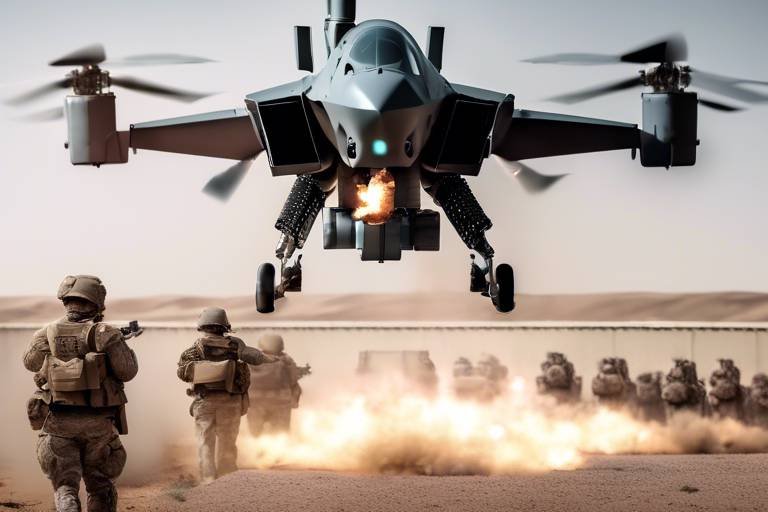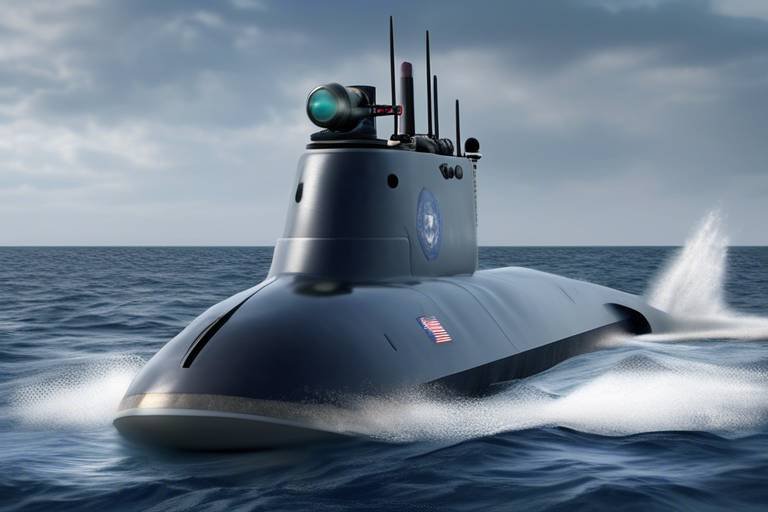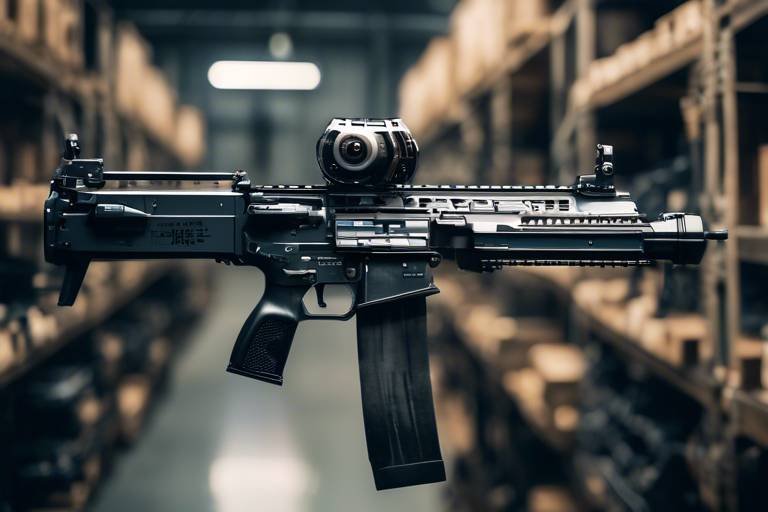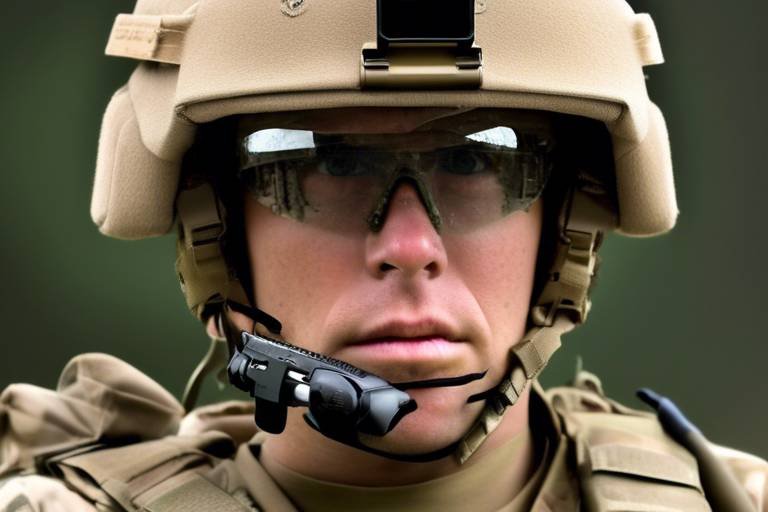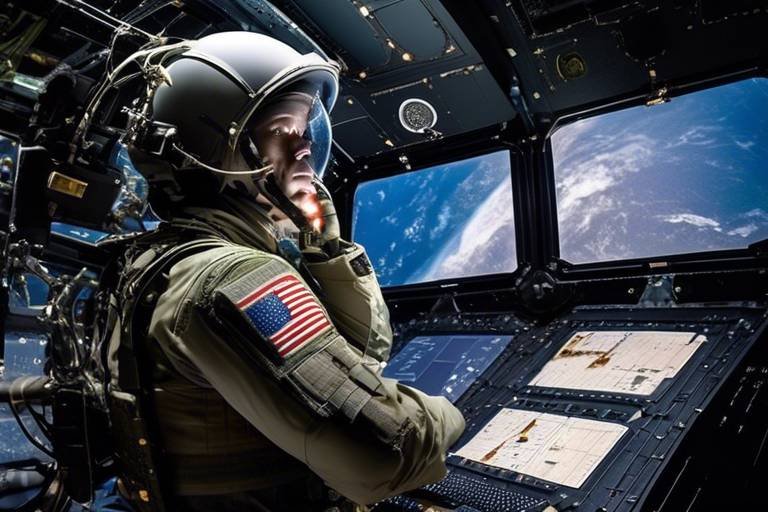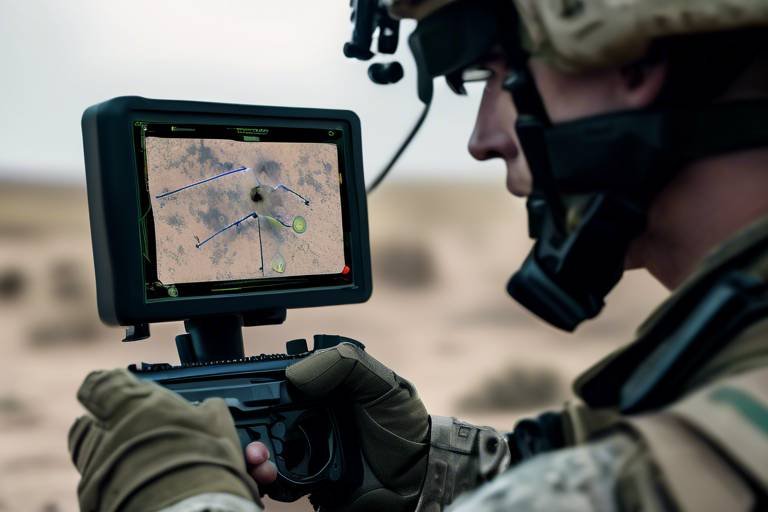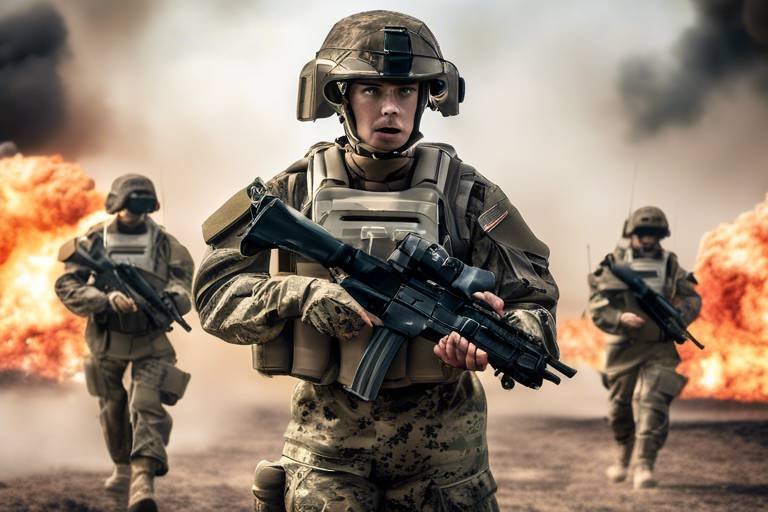How AI is Shaping the Future of Military Strategy
In an era where technology evolves at a breakneck pace, the military landscape is undergoing a seismic shift, driven predominantly by the rise of artificial intelligence (AI). This transformation is not just a trend; it’s a revolution that is redefining how military operations are conducted, reshaping strategy development, and altering the decision-making processes that have long governed warfare. Imagine a battlefield where data is king, and the ability to analyze that data swiftly can mean the difference between victory and defeat. The integration of AI into military strategy is not merely about enhancing existing capabilities; it’s about creating entirely new paradigms of operation that challenge our traditional understanding of warfare.
AI technologies are enhancing the way militaries analyze data, automate tasks, and improve situational awareness. For instance, consider how AI can process vast amounts of information from various sources, such as satellite imagery, social media, and reconnaissance reports, in a fraction of the time it would take a human analyst. This capability leads to more efficient military operations, allowing forces to respond to threats with unprecedented speed and precision. As we delve deeper into this topic, we’ll explore the multifaceted role of AI in modern warfare, its potential for revolutionizing decision-making, and the ethical considerations that arise from its use.
Today’s battlefield is not just a physical space; it’s a complex environment filled with data points that must be analyzed and interpreted. AI technologies are redefining combat strategies by enhancing data analysis capabilities. Imagine a war room where military leaders can visualize the battlefield in real-time, with AI tools providing insights that were previously unimaginable. This is not science fiction; it’s the new reality of modern warfare.
AI enhances situational awareness by processing information from multiple sources simultaneously. For example, during an engagement, AI can analyze drone footage, satellite images, and ground intelligence to provide commanders with a comprehensive view of the battlefield. This level of insight enables military leaders to make informed decisions quickly, adapting their strategies based on real-time data. Furthermore, AI can automate mundane tasks, freeing up personnel to focus on critical decision-making processes.
In the fast-paced world of military operations, rapid decision-making is crucial. AI facilitates this by processing vast amounts of data in real-time, allowing military leaders to respond swiftly to dynamic situations. For instance, during a conflict, AI can analyze enemy movements and predict potential threats, enabling commanders to adjust their strategies proactively. This predictive capability is a game-changer, enhancing military readiness and operational success.
With AI, predictive analytics has become a powerful tool in combat scenarios. By analyzing historical data and current trends, AI can forecast enemy movements and identify potential threats before they materialize. This foresight allows military planners to devise proactive strategies, ensuring that they are always one step ahead of the adversary. Imagine having a crystal ball that not only tells you what the enemy might do next but also suggests the best course of action to counter it. That’s the power of AI-driven predictive analytics.
Advanced data collection techniques, such as satellite imagery and drone surveillance, play a critical role in feeding AI algorithms with the information they need to generate actionable insights. These technologies provide a wealth of data that can be analyzed to understand enemy positions, movements, and capabilities. The synergy between data collection and AI analysis is what makes modern military operations so effective.
AI systems excel in evaluating real-time data to assess threats. By continuously monitoring the battlefield, these systems allow commanders to make informed decisions about resource allocation and tactical maneuvers during engagements. For instance, if an AI system detects an increase in enemy activity in a particular area, it can alert commanders, who can then decide whether to reinforce that position or adjust their strategy accordingly.
The integration of autonomous systems and robotics in military operations is revolutionizing logistics, reconnaissance, and combat roles. These technologies not only reduce human risk but also increase operational efficiency. Imagine sending a drone into hostile territory to gather intelligence or deploy supplies without putting soldiers in harm's way. The implications of this technology are profound, as it allows for more strategic resource management and the ability to conduct operations in environments that would be too dangerous for human personnel.
While the benefits of AI in military contexts are undeniable, they also raise significant ethical questions. The deployment of AI in warfare challenges our traditional notions of accountability, decision-making autonomy, and the potential for unintended consequences. As we embrace these technologies, it’s crucial to consider the moral implications of their use.
One of the most pressing issues is determining accountability for actions taken by AI systems in combat situations. If an AI makes a mistake, who is responsible? This question necessitates clear guidelines and regulations to govern the use of AI in military operations. Without these frameworks, the risk of misuse or unintended consequences increases dramatically.
The development of fully autonomous weapons systems raises concerns about the loss of human oversight. As these systems become more capable, the implications for international warfare norms and humanitarian law must be carefully considered. The idea of machines making life-and-death decisions without human intervention is a troubling prospect that warrants serious discussion and regulation.
- What is the primary benefit of AI in military operations? AI enhances data analysis and situational awareness, leading to more efficient decision-making and operational success.
- How does AI improve decision-making in combat? AI processes vast amounts of data quickly, allowing military leaders to respond to dynamic situations with greater speed and accuracy.
- What ethical concerns are associated with AI in warfare? Key concerns include accountability for AI-driven actions and the potential for autonomous weapons to operate without human oversight.

The Role of AI in Modern Warfare
Artificial Intelligence (AI) is not just a buzzword in today's tech-driven world; it's a game-changer on the battlefield. Imagine a world where military operations are not only faster but also smarter. AI technologies are redefining combat strategies by enhancing data analysis, automating tasks, and improving situational awareness. This transformation leads to more efficient military operations, allowing forces to adapt to the ever-changing dynamics of warfare.
In the past, military decision-making relied heavily on human intuition and experience, which, while invaluable, could be slow and prone to error. With AI, we are entering an era where algorithms can process vast amounts of data in a fraction of the time it takes a human. For instance, AI can analyze satellite imagery, drone footage, and intelligence reports almost instantaneously, providing commanders with a comprehensive view of the battlefield. This capability not only enhances operational efficiency but also minimizes the risk to human life.
Consider the following key areas where AI is making a significant impact:
- Data Analysis: AI systems can sift through mountains of data to identify patterns and insights that would be nearly impossible for humans to discern quickly.
- Task Automation: Routine tasks such as logistics management and supply chain operations can be automated, freeing up personnel for more critical missions.
- Situational Awareness: Real-time data integration from various sources allows military leaders to maintain a clear picture of the battlefield, enhancing decision-making.
Moreover, AI's ability to enhance situational awareness is particularly crucial in modern warfare, where the speed of information can dictate success or failure. Imagine a commander receiving real-time updates on troop movements, enemy locations, and environmental conditions—all processed and analyzed by AI. This level of insight enables military leaders to make informed decisions quickly, responding to threats before they escalate.
However, with great power comes great responsibility. The integration of AI in military operations raises questions about reliability and the potential for over-reliance on technology. While AI can significantly enhance operational capabilities, it's essential to remember that human oversight remains crucial. The balance between leveraging AI's advantages and ensuring that human judgment is not sidelined is a delicate one.
In conclusion, the role of AI in modern warfare is transformative. It enhances data analysis, automates routine tasks, and improves situational awareness, ultimately leading to more efficient military operations. As we continue to integrate these technologies into our defense strategies, we must remain vigilant about the challenges and ethical considerations that accompany this powerful tool.
- How does AI improve situational awareness in military operations?
AI enhances situational awareness by processing real-time data from various sources, allowing military leaders to maintain an accurate and up-to-date understanding of the battlefield. - What are the risks of relying on AI in warfare?
The primary risks include over-reliance on technology, potential errors in AI decision-making, and ethical concerns regarding accountability for actions taken by AI systems. - Can AI completely replace human decision-making in military contexts?
No, while AI can assist in decision-making, human judgment and oversight are essential to ensure ethical and effective outcomes.

AI-Driven Decision Making
In the fast-paced world of modern warfare, time is of the essence. Military leaders are often faced with complex situations that require quick and informed decisions. This is where artificial intelligence (AI) steps in as a game-changer. By harnessing the power of AI, military strategists can process vast amounts of data in real-time, making it possible to respond to dynamic battlefield conditions with unprecedented speed and accuracy. Imagine trying to solve a massive jigsaw puzzle with pieces scattered all over the place; AI acts as a supercharged assistant, rapidly organizing and analyzing each piece to reveal the bigger picture.
One of the most significant advantages of AI-driven decision-making is its ability to analyze data from multiple sources simultaneously. For instance, AI can integrate information from satellite imagery, drone surveillance, and ground-based sensors, creating a comprehensive situational awareness that was previously unattainable. This holistic view allows commanders to assess threats, allocate resources efficiently, and formulate strategies that are not just reactive, but also proactive.
Moreover, AI algorithms can identify patterns and trends that might go unnoticed by human analysts. For example, by examining historical conflict data, AI can predict potential flashpoints and recommend preemptive actions. This capability is akin to having a crystal ball that not only reveals possible future scenarios but also suggests the best course of action based on past experiences. As a result, military operations can shift from a reactive stance to a more strategic, foresighted approach.
However, the integration of AI into decision-making processes is not without its challenges. One major concern is the risk of over-reliance on technology. While AI can provide valuable insights, it is crucial that human judgment remains at the forefront of military operations. The balance between human intuition and AI analysis is essential to ensure that decisions are not only data-driven but also ethically sound and contextually relevant.
To illustrate the potential impact of AI-driven decision-making, consider the following table that outlines key benefits and challenges:
| Benefits of AI-Driven Decision Making | Challenges of AI-Driven Decision Making |
|---|---|
| Enhanced situational awareness | Over-reliance on technology |
| Faster response times | Data privacy and security issues |
| Improved predictive capabilities | Ethical concerns regarding accountability |
| Resource optimization | Potential for unintended consequences |
In conclusion, AI-driven decision-making is reshaping the landscape of military strategy by providing tools that enhance efficiency and effectiveness. As we move forward, it is essential to embrace these technological advancements while remaining vigilant about the ethical implications and potential pitfalls. The future of warfare may very well depend on our ability to strike a balance between human intuition and machine intelligence.
- How does AI improve decision-making in the military?
AI enhances decision-making by processing large datasets quickly, providing actionable insights, and predicting potential threats based on historical data. - What are the risks of using AI in military operations?
Risks include over-reliance on technology, ethical concerns regarding accountability, and potential data security issues. - Can AI completely replace human decision-making in the military?
No, while AI can assist in decision-making, human judgment and ethical considerations must remain central to military operations.

Predictive Analytics in Combat
In the ever-evolving landscape of military strategy, predictive analytics has emerged as a game-changer. Imagine having the ability to foresee enemy movements and potential threats before they even occur. This is precisely what AI-driven predictive analytics offers. By harnessing vast amounts of data, military leaders can anticipate actions and make informed decisions that enhance operational readiness. It’s like having a crystal ball that reveals the battlefield’s future, allowing commanders to stay one step ahead of their adversaries.
At the core of predictive analytics lies the ability to process and analyze data from various sources. For example, satellite imagery, intelligence reports, and even social media activity can provide insights into enemy behavior. By applying complex algorithms, AI systems can identify patterns and trends that human analysts might overlook. This capability not only improves situational awareness but also allows for the development of proactive strategies. Just think about it: instead of reacting to threats, military forces can position themselves advantageously, ready to counter any move the enemy makes.
One of the most compelling aspects of predictive analytics is its ability to enhance military readiness. By predicting potential flashpoints and conflict zones, armed forces can allocate resources more effectively. For instance, if data suggests an increase in troop movements in a specific region, commanders can bolster their presence there, ensuring they are prepared for any escalation. This dynamic approach to resource allocation can significantly improve the odds of success in combat situations.
However, it’s essential to recognize that predictive analytics is not infallible. While it can provide valuable insights, there are inherent uncertainties in any predictive model. Factors such as human behavior, environmental conditions, and unforeseen events can impact the accuracy of predictions. Therefore, military leaders must use predictive analytics as a tool to inform their decisions, rather than relying solely on it. The integration of human intuition and experience remains crucial in interpreting the data and making strategic choices.
In conclusion, predictive analytics in combat represents a significant leap forward in military strategy. By leveraging AI to forecast enemy movements and assess potential threats, armed forces can enhance their operational effectiveness. As technology continues to advance, the role of predictive analytics is likely to expand, shaping the future of warfare in ways we are just beginning to understand.
- What is predictive analytics in military combat?
Predictive analytics involves using AI to analyze data and forecast enemy movements and potential threats, enabling proactive military strategies. - How does AI improve military readiness?
AI helps in assessing data from various sources to predict conflict zones, allowing military forces to allocate resources effectively and prepare for potential escalations. - Are there limitations to predictive analytics?
Yes, while predictive analytics can provide valuable insights, it is not foolproof. Human behavior and unforeseen events can impact the accuracy of predictions.

Data Collection Techniques
In the ever-evolving landscape of military operations, the significance of cannot be overstated. These techniques serve as the backbone of modern warfare, enabling military planners to gather crucial information that informs strategy and enhances operational effectiveness. The integration of advanced technologies has revolutionized how data is collected, analyzed, and utilized in real-time combat scenarios.
One of the primary methods of data collection is through satellite imagery. Satellites equipped with high-resolution cameras provide an aerial view of the battlefield, allowing military analysts to monitor enemy movements, infrastructure, and troop deployments. This bird's-eye perspective is invaluable for developing situational awareness and anticipating potential threats. The data collected from satellites can be processed by AI algorithms to generate actionable insights, transforming raw images into strategic intelligence.
Another pivotal technique is drone surveillance. Drones, or unmanned aerial vehicles (UAVs), have become essential tools for reconnaissance missions. They can fly over hostile territories, capturing real-time video feeds and images without putting human lives at risk. These UAVs can be equipped with various sensors, including infrared and radar, to detect hidden enemy positions or movements, even in challenging weather conditions. The data collected by drones is often transmitted back to command centers, where AI systems analyze it to provide commanders with a comprehensive understanding of the battlefield.
Additionally, ground sensors play a crucial role in data collection. These sensors can be deployed in strategic locations to monitor troop movements, detect sounds, and even sense vibrations from vehicles or footsteps. The information gathered from these sensors is invaluable for creating a detailed picture of the operational environment. When combined with AI, the data can be analyzed to identify patterns and predict enemy actions, enhancing military readiness.
Furthermore, social media and open-source intelligence have emerged as unconventional but effective data collection methods. Military analysts now monitor social media platforms for real-time updates and sentiment analysis related to conflict zones. This approach allows them to gauge public opinion and anticipate potential uprisings or support for military actions. The ability to harness information from diverse sources enriches the intelligence pool and aids in crafting well-informed strategies.
As we delve deeper into the realm of data collection techniques, it's essential to recognize the importance of data integration. The fusion of information from various sources—satellites, drones, ground sensors, and social media—creates a holistic view of the battlefield. AI systems can process this integrated data, enabling military leaders to make informed decisions rapidly. The synergy between different data collection methods enhances situational awareness and operational success, paving the way for a new era in military strategy.
- What are the primary data collection techniques used in modern warfare?
Modern warfare relies on satellite imagery, drone surveillance, ground sensors, and social media intelligence to gather crucial data. - How does AI enhance data collection in military operations?
AI processes and analyzes vast amounts of data collected from various sources, providing actionable insights and improving decision-making. - What role do drones play in military data collection?
Drones conduct reconnaissance missions by capturing real-time video and images, allowing for detailed surveillance without risking human lives. - Can social media be a reliable source of military intelligence?
Yes, monitoring social media can provide real-time updates and insights into public sentiment, which can be critical for anticipating developments in conflict zones.

Real-Time Threat Assessment
In the fast-paced environment of modern warfare, the ability to assess threats in real-time can mean the difference between victory and defeat. Artificial intelligence plays a pivotal role in this process, utilizing advanced algorithms to analyze vast amounts of data from various sources. Imagine a battlefield where every movement is monitored, every decision is informed by precise data analysis, and commanders can predict enemy actions before they even occur. This is not science fiction; it's the reality of AI-driven military operations.
AI systems are designed to evaluate incoming data from multiple channels, including satellite feeds, drone surveillance, and ground sensors. By integrating this information, these systems can provide a comprehensive picture of the battlefield. For instance, if a military unit is engaged in a skirmish, AI can analyze real-time data to assess the enemy's strength, location, and potential reinforcements. This capability allows commanders to make informed decisions regarding troop movements, resource allocation, and tactical maneuvers.
One of the most exciting aspects of real-time threat assessment is the speed at which AI can operate. Traditional methods of data analysis often take valuable time—time that could be spent reacting to threats. AI, on the other hand, can process and analyze data in mere seconds. This rapid assessment enables military leaders to respond swiftly to dynamic situations, ensuring that their forces remain one step ahead of the enemy. In essence, AI acts as a force multiplier, enhancing the effectiveness of military operations.
However, the implementation of AI in threat assessment is not without its challenges. There are concerns about the reliability of AI systems, particularly when it comes to making critical decisions in high-stakes scenarios. What happens if an AI misinterprets data? The consequences could be catastrophic. Therefore, it is crucial for military leaders to maintain oversight and ensure that human judgment is always a part of the decision-making process.
Moreover, as we advance into an era where AI systems become more autonomous, the need for robust ethical guidelines becomes paramount. The military must navigate the fine line between leveraging AI for enhanced operational efficiency and ensuring that human oversight remains intact to prevent unintended consequences. Establishing clear protocols for AI-driven threat assessment will help mitigate risks and enhance operational success.
In summary, real-time threat assessment powered by AI is revolutionizing the way military operations are conducted. By providing accurate, timely insights, AI enables military leaders to make informed decisions that can significantly improve the outcomes of engagements. As we continue to explore the potential of AI in warfare, it is essential to strike a balance between technological advancement and ethical responsibility.
- What is real-time threat assessment in military operations?
Real-time threat assessment refers to the continuous analysis of data to identify and evaluate potential threats during military operations. AI enhances this process by providing rapid insights based on data from various sources. - How does AI improve decision-making in combat?
AI processes vast amounts of data quickly, allowing military leaders to make informed decisions that can adapt to changing battlefield conditions, ultimately improving the effectiveness of operations. - Are there risks associated with AI in military applications?
Yes, there are risks, including potential misinterpretation of data, over-reliance on technology, and ethical concerns regarding accountability and decision-making autonomy.

Autonomous Systems and Robotics
Autonomous systems and robotics are not just the stuff of science fiction anymore; they are becoming integral components of modern military operations. Imagine a battlefield where robots and drones execute complex missions without the need for constant human oversight. This revolutionary shift is not only enhancing operational efficiency but also significantly reducing the risks faced by human soldiers. As these technologies evolve, they bring with them a wave of possibilities that could reshape how wars are fought.
One of the most exciting aspects of autonomous systems is their ability to perform reconnaissance missions. Drones equipped with advanced sensors can fly over hostile territories, gathering intelligence that would be too dangerous for human pilots. These unmanned aerial vehicles (UAVs) can operate in environments that are inhospitable or perilous, providing real-time data that can be analyzed by military planners. This capability allows for a more informed approach to strategy, as commanders can make decisions based on accurate and timely information.
Moreover, robotics in logistics is another game-changer. Imagine automated supply trucks that can navigate through treacherous terrains, delivering essential supplies to troops on the front lines without risking human lives. This not only streamlines the supply chain but also ensures that resources reach those who need them without delay. The efficiency gained from these technologies can make the difference between victory and defeat in critical situations.
However, the integration of autonomous systems is not without its challenges. For instance, there are concerns about the reliability of these technologies. What happens if a drone malfunctions during a crucial mission? Or worse, what if it is hacked and used against its own forces? These questions underscore the need for robust security measures and contingency plans to ensure that these systems can operate safely and effectively.
Furthermore, the ethical implications of deploying robots in combat scenarios are significant. While they can reduce human casualties, the idea of machines making life-and-death decisions raises moral dilemmas. Who is responsible if an autonomous weapon mistakenly targets civilians? The military must grapple with these questions as they continue to develop and deploy these technologies.
In summary, autonomous systems and robotics are set to revolutionize military operations by enhancing efficiency, improving reconnaissance capabilities, and streamlining logistics. However, as we embrace these advancements, it is crucial to address the accompanying challenges and ethical considerations to ensure that their deployment is both effective and responsible.
- What are autonomous systems?
Autonomous systems are machines that can perform tasks without human intervention, utilizing artificial intelligence to make decisions based on their programming and environmental data.
- How do robots enhance military operations?
Robots enhance military operations by performing dangerous tasks, conducting reconnaissance, and delivering supplies, thereby reducing the risk to human soldiers.
- What are the ethical concerns regarding military robots?
Ethical concerns include accountability for actions taken by robots, the potential for civilian casualties, and the implications of removing human oversight from critical decisions.

Ethical Considerations of AI in the Military
As we stand on the brink of a new era in warfare, the integration of artificial intelligence into military operations brings forth a myriad of ethical considerations that cannot be ignored. The potential for AI to change the landscape of combat raises questions about accountability, decision-making autonomy, and the implications for humanitarian law. To begin with, let’s consider the fundamental issue of accountability in AI-driven actions.
When a military operation is executed with the assistance of AI, who is responsible for the outcomes? If an autonomous system makes a decision that leads to unintended consequences, such as civilian casualties, the question of accountability becomes murky. Is it the programmer, the military leader who deployed the technology, or the AI itself? This ambiguity necessitates the establishment of clear guidelines and regulations to govern the use of AI in military contexts. Without these, there is a risk that accountability will become diluted, leaving a dangerous gap in responsibility.
Moreover, the development of fully autonomous weapons systems introduces an additional layer of complexity. These systems, capable of making life-and-death decisions without human intervention, challenge traditional norms of warfare and raise significant ethical dilemmas. Imagine a scenario where a drone autonomously decides to engage a target based on pre-programmed criteria. What happens if that target is misidentified? The implications for international warfare norms and humanitarian law are profound, as the absence of human oversight could lead to violations of ethical standards that have been painstakingly established over decades.
Furthermore, the potential for AI to exacerbate the already existing issues of bias in military operations cannot be overlooked. AI systems learn from data, and if that data contains biases—whether intentional or unintentional—those biases can be perpetuated and even amplified in decision-making processes. This raises the question: how do we ensure that AI systems operate fairly and justly? It is crucial for military organizations to implement rigorous testing and validation processes to mitigate bias and ensure that AI systems are making decisions based on factual, unbiased data.
In addition to accountability and bias, the psychological impact of AI on military personnel is another ethical concern. As soldiers increasingly rely on AI for support in combat scenarios, there may be a diminishing sense of personal responsibility for actions taken during warfare. This shift could lead to a desensitization to violence and a detachment from the moral implications of combat, fundamentally altering the nature of military service.
To address these ethical considerations, it is essential for military leaders and policymakers to engage in ongoing discussions about the role of AI in warfare. This includes establishing international norms and agreements that govern the use of AI technologies in military contexts. By fostering a collaborative approach that involves ethicists, technologists, and military strategists, we can work towards a future where AI enhances military capabilities while adhering to ethical standards that prioritize human life and dignity.
- What are the main ethical concerns regarding AI in the military? The primary concerns include accountability for AI-driven actions, the potential for bias in decision-making, the implications of autonomous weapons, and the psychological impact on military personnel.
- How can accountability be ensured in AI military operations? Establishing clear guidelines and regulations, along with rigorous testing and validation processes, can help ensure accountability in AI-driven military actions.
- What role do international norms play in regulating AI in warfare? International norms can help set standards for the ethical use of AI in military contexts, promoting adherence to humanitarian law and preventing misuse of technology.

Accountability in AI-Driven Actions
The increasing integration of artificial intelligence in military operations brings forth a complex web of accountability issues that demand urgent attention. As we venture into an era where machines can make decisions that could lead to life or death scenarios, the question arises: who is responsible for these decisions? This dilemma is not merely academic; it has profound implications for military ethics, law, and international relations.
When AI systems are deployed in combat situations, they often operate with a level of autonomy that can blur the lines of accountability. For instance, if an AI-driven drone makes a decision to engage a target, who is to blame if that decision leads to civilian casualties? Is it the programmer who wrote the algorithm, the military leader who authorized its use, or the machine itself? These questions highlight the need for robust guidelines that can clearly outline responsibility in AI-driven actions.
Moreover, the potential for AI systems to learn and adapt raises additional concerns. As these systems evolve, their decision-making processes may become opaque, making it difficult to trace the rationale behind their actions. This lack of transparency can hinder accountability and complicate legal and ethical evaluations. To address these challenges, several key considerations must be taken into account:
- Clear Guidelines: Establishing comprehensive regulations that define the limits of AI autonomy in combat situations is crucial. This includes specifying the roles of human operators and the circumstances under which AI can make independent decisions.
- Transparency: AI systems must be designed to provide insights into their decision-making processes. This transparency can foster trust and allow for better accountability.
- Training and Oversight: Military personnel must receive adequate training to understand AI systems and their limitations. Continuous oversight is necessary to ensure these systems are used ethically and responsibly.
As we navigate this uncharted territory, it's essential that military organizations engage in ongoing discussions about the ethical implications of AI. Establishing accountability mechanisms will not only protect human lives but also uphold the moral standards that govern modern warfare. In doing so, we can harness the benefits of AI while mitigating the risks associated with its deployment in military contexts.
- What are the main challenges of accountability in AI-driven military actions?
The primary challenges include determining who is responsible for decisions made by AI, ensuring transparency in AI decision-making processes, and establishing clear guidelines for the use of AI in combat. - How can military organizations ensure ethical AI use?
By implementing strict regulations, providing thorough training for personnel, and maintaining oversight of AI systems, military organizations can promote ethical use of AI technologies. - What role does transparency play in AI accountability?
Transparency allows for better understanding and tracing of AI decisions, which is crucial for accountability and ethical evaluations in military operations.

Potential for Autonomous Weapons
The emergence of autonomous weapons systems is a profound shift in the landscape of military technology. These systems, capable of operating without direct human control, promise to revolutionize warfare by enhancing precision and efficiency. However, with great power comes great responsibility, and the implications of deploying such technology are both exciting and alarming. Imagine a battlefield where machines make life-and-death decisions without human intervention—it's a scenario that raises numerous ethical and practical concerns.
At the heart of the debate is the question of human oversight. While autonomous weapons can reduce the risk to soldiers by taking on dangerous tasks, the absence of human judgment in critical situations could lead to catastrophic mistakes. For instance, if an autonomous drone misidentifies a target, the consequences could be devastating. This brings us to the critical need for accountability. Who is responsible when a machine makes a fatal error? Is it the programmer, the military leader, or the technology itself? These questions are not just theoretical; they demand urgent answers as nations race to develop these systems.
Furthermore, the potential for unintended escalation in conflicts is another pressing concern. Autonomous weapons could trigger rapid responses that outpace human decision-making, leading to situations where conflicts escalate beyond control. For example, if one side deploys an autonomous weapon, the opposing force may feel compelled to respond in kind, resulting in a dangerous arms race. This scenario highlights the need for international regulations governing the use of autonomous systems to ensure they are employed responsibly and ethically.
As we navigate these complex issues, it’s crucial to consider the moral implications of allowing machines to make life-and-death decisions. The principles of international humanitarian law emphasize the need for distinction and proportionality in warfare—principles that may be challenging to uphold when machines are in charge. Can we trust algorithms to interpret the nuances of human conflict? The potential for bias in AI systems further complicates this issue, as decisions made by flawed algorithms could lead to unjust outcomes.
In conclusion, while the potential for autonomous weapons systems to enhance military capabilities is undeniable, the challenges they present cannot be overlooked. Striking a balance between innovation and ethical responsibility is essential to ensure that the future of warfare remains aligned with humanitarian values. As nations move forward with the development of these technologies, ongoing dialogue and cooperation will be key to establishing a framework that governs their use.
- What are autonomous weapons? Autonomous weapons are military systems capable of selecting and engaging targets without human intervention.
- What are the ethical concerns surrounding autonomous weapons? Key concerns include accountability for actions taken by these systems, the potential for unintended escalation in conflicts, and the moral implications of machines making life-and-death decisions.
- How can we ensure the responsible use of autonomous weapons? Establishing clear international regulations and guidelines is essential to govern the development and deployment of autonomous weapons, ensuring they comply with humanitarian laws.
- Could autonomous weapons lead to an arms race? Yes, the deployment of autonomous weapons by one nation may prompt others to develop similar technologies, potentially leading to an arms race and increased global tensions.
Frequently Asked Questions
- What is the role of AI in modern military operations?
AI plays a crucial role in modern military operations by enhancing data analysis, automating tasks, and improving situational awareness. This leads to more efficient and effective military strategies, allowing forces to respond to threats and challenges with greater agility.
- How does AI facilitate decision-making in the military?
AI facilitates decision-making by processing vast amounts of data quickly. This capability allows military leaders to make informed decisions in real-time, improving the effectiveness of operations and enabling rapid responses to dynamic combat situations.
- What is predictive analytics in combat?
Predictive analytics involves using AI to forecast enemy movements and potential threats. By analyzing historical and real-time data, military planners can develop proactive strategies that enhance readiness and operational success on the battlefield.
- What data collection techniques are used in military AI?
Advanced data collection techniques include satellite imagery, drone surveillance, and other reconnaissance methods. These technologies gather critical information that AI algorithms analyze to generate actionable insights for military operations.
- How does AI assist in real-time threat assessment?
AI systems evaluate real-time data to assess threats, enabling commanders to make informed decisions about resource allocation and tactical maneuvers. This capability is vital for maintaining an advantage during engagements.
- What are autonomous systems and how are they used in the military?
Autonomous systems, including drones and robotic units, are integrated into military operations to revolutionize logistics, reconnaissance, and combat roles. They reduce human risk and increase operational efficiency, allowing for safer and more effective missions.
- What ethical considerations arise from using AI in the military?
The deployment of AI in military contexts raises ethical questions about accountability, decision-making autonomy, and the potential for unintended consequences. These issues necessitate careful consideration and clear guidelines to govern the use of AI technologies.
- How is accountability determined for AI-driven actions?
Determining accountability for actions taken by AI systems in combat situations is complex. It requires establishing clear regulations and guidelines that define the responsibilities of military personnel and the AI systems they operate.
- What are the concerns regarding autonomous weapons?
The development of fully autonomous weapons systems raises significant concerns about the loss of human oversight. This could have serious implications for international warfare norms and humanitarian law, prompting debates about the ethical use of such technologies.

